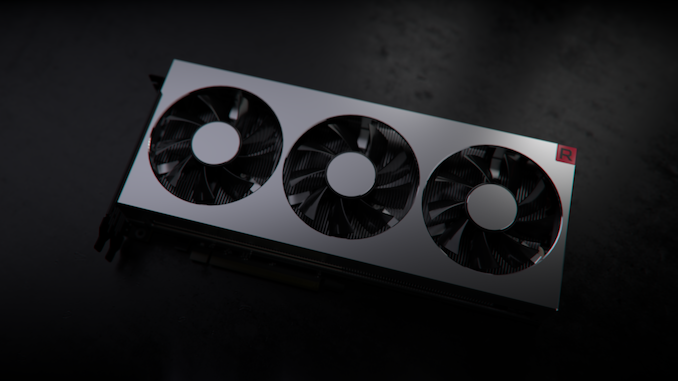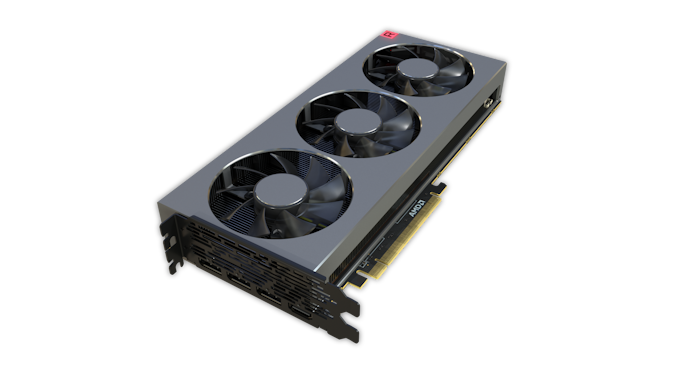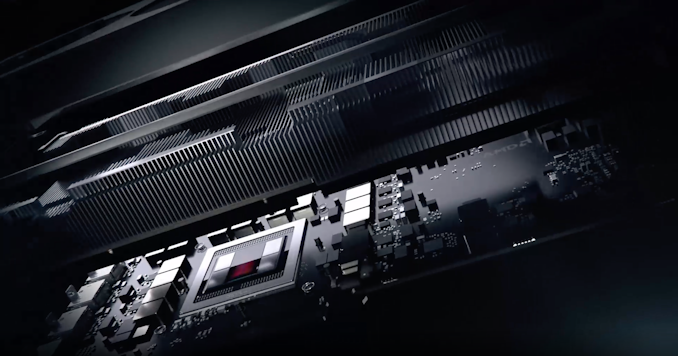The AMD Radeon VII Review: An Unexpected Shot At The High-End
by Nate Oh on February 7, 2019 9:00 AM ESTMeet The Radeon VII
First things first is the design and build, and for the AMD Radeon VII, we've already noticed the biggest change: an open air cooler. Keeping the sleek brushed metal look of the previous RX Vega 64 Limited Edition and Liquid variants, they've forgone the blower for a triple axial fan setup, the standard custom AIB configuration for high-end cards.
While NVIDIA's GeForce RTX series went this way with open-air dual-fan coolers, AMD is no stranger to changing things up themselves. Aside from the RX Vega 64 Liquid, the R9 Fury X's AIO CLC was also quite impressive for a reference design. But as we mentioned with the Founders Edition cards, moving away from blowers for open-air means adopting a cooling configuration that can no longer guarantee complete self-cooling. That is, cooling effectiveness won't be independent of chassis airflow, or lack thereof. This is usually an issue for large OEMs that configure machines assuming blower-style cards, but this is less the case for the highest-end cards, which for pre-builts tend to come from boutique system integrators.
The move to open-air does benefit higher TDP, and at 300W TBP the Radeon VII is indeed one for higher power consumption. While 5W more than the RX Vega 64, there's presumably more localized heat with two more HBM2 stacks, plus the fact that the same amount of power is being consumed but on a smaller die area. And at 300W TBP, this would mean that all power-savings from the smaller process were re-invested into performance. If higher clockspeeds are where the Radeon VII is bringing the majority of its speedup over RX Vega 64, then there would be little alternative to abandoning the blower.
Returning to the Radeon VII build, then, the card naturally has dual 8-pin PCIe connectors, but lacks the BIOS switch of the RX Vega cards that toggled a lower-power BIOS. And with the customary LEDs, the 'Radeon' on the side lights up, as does the 'R' cube in the corner.
In terms of display outputs, there are no surprises here with 3x DisplayPort and 1x HDMI.
A few teardowns of the card elsewhere revealed a vapor chamber configuration with a thermal pad for the TIM, rather than the usual paste. While lower-performing in terms of heat transfer, we know that the RX Vega cards ended up having molded and unmolded package variants, requiring specific instructions to manufacturers on the matter. So this might be a way to head off potential ASIC height difference issues.














289 Comments
View All Comments
eva02langley - Thursday, February 7, 2019 - link
I should not say realistic, I should say credible.webdoctors - Thursday, February 7, 2019 - link
Open source is NOT the only way a new standard can be adopted. Microsoft has been pushing DirectX 9/10/11, etc. and those are HUGELY popular standards. If MS is adopting it in their API, than yes it'll show up in PC games.Raytracing is not a gimmick, its been around since before you were born or Nvidia was even founded. It hasn't been "feasible" for real-time and as such as been largely ignored in gaming. Many other technologies were not feasible until they were and than got incorporated. Graphics is more than just getting 60FPS otherwise everything would just be black and white without shadows. Its about realism, which means proper lighting, shadows, physics.
Ppl need to call out the price, if you're a regular joe who's just getting a card for gaming and not mining or business use, why would you buy this over the competition? They seriously need to drop the price by $100 or it'll be a tiny seller.
D. Lister - Friday, February 8, 2019 - link
RTX is just Nvidia's way of doing DXR which is the IP of Microsoft. AMD has already announced specific development for it in future to be integrated in their GPU's. RT has been announced by both Sony and MS for their next consoles. Of course because of their use of AMD GPUs, the application of RT would be of a lower quality compared to what RTX can do. It is very much like the current console implementation of anti-aliasing, HBAO or tessellation, where on consoles you get a very basic level of those features, but on decent PCs they can be cranked up much higher."The whole G-synch fiasco should have been enough to prove it."
This is nothing like G-Sync. The problem with GSync is the extra cost. Now considering that the 2080 is the same price/performance as a Radeon VII, but has hardware DXR (RTX) as well, you're essentially getting the ray-tracing add-in for free.
Thirdly, while many things can be faked with rasterization to be within the approximation of ray-tracing, it requires far greater work (not to mention, artistic talent) to do it. In rasterization, a graphics designer has to first guess what a certain reflection or shadow would look like and then painstakingly make something that could pass off for the real thing. Raytracing takes that guesswork out of the task. All you, as a developer, would need to do is place a light or a reflective surface and RT would do the rest with mathematical accuracy, resulting in higher quality, a much faster/smoother development, fewer glitches, and a much smaller memory/storage footprint for the final product.
D. Lister - Friday, February 8, 2019 - link
A helpful link:https://blogs.msdn.microsoft.com/directx/2018/03/1...
Manch - Friday, February 8, 2019 - link
RTX is a proprietary implementation that is compatible with DirectX RT. AMD may eventually do DirectX RT but it will be there own version. As far as consoles go, unless NAVI has some kind of RT implementation, youre right, no RT of any significance. At best it will be a simple PC graphics option that works in a few titles maybe like hair works lol.eva02langley - Friday, February 8, 2019 - link
It is ... a GAMEWORKS feature... as of now. RTX/DLSS are nothing more than 2 new gameworks features... that will just break games, once again to cripple the competition.The goal is not even to have RTX or DLSS, it is to force developers to use their proprietary tools to break game codes and sabotage the competition, like The Witcher 3.
RTX is nothing good as of now. It is a tax, and it breaks performances. Let's talk about it when it can be implemented in real-time. until then, let's Nvidia feel the burden of it.
eddman - Friday, February 8, 2019 - link
I do agree that these RTX/DLSS features absolutely do not justify the current prices and that nvidia should've waited for 7nm to mature before adding them, but let's not get so emotional.Gameworks are simply modules that can be added to a game and are not part of the main code. Also, its GPU based features can be disabled in options, as was the case in witcher 3.
TheinsanegamerN - Thursday, February 7, 2019 - link
And by flinging insults you have shown yourself to be an immature fanboi that is desperately trying to defend his favorite GPU company.eva02langley - Friday, February 8, 2019 - link
I didn't insult anyone, I just spoke the truth about RTX. I am not defending AMD, I am condemning Nvidia. Little difference...To defend RTX as it is today, is being colored green all over. There is no way to defend it.
ballsystemlord - Thursday, February 7, 2019 - link
I agree, Huang should have listed to himself when he said that Ray tracing would have been a thing in 10 years (but he wanted to bring it to market now).Remember when there were 2D and 3D accelerators?
I say we should be able to choose 3D or Ray-tracing accelerators.